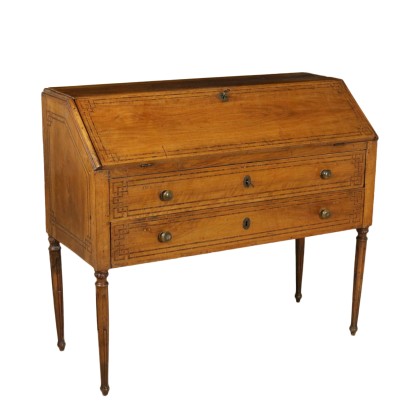Neoclassical Drop-leaf Secretaire
Features
Style: Neo-Classical (1765-1790)
Age: 18th Century / 1701 - 1800
Year: Ultimo quarto '700
Origin: Emilia Romagna, Italy
Main essence: Walnut , Rosewood
Description
A drop-leaf secretaire supported by cabled conical feet with carved capitals. A pair of drawers with a drop-leaf door. Inner glass cabinet with four drawers and an open compartment. Double inlaid threading with Greek frets. Manufactured in Italy, last quarter of the 18th century.
Product Condition:
The item shows signs of wear due to age. Any damage or loss is displayed as completely as possible in the pictures. It may require restoration and polishing.
Dimensions (cm):
Height: 105
Width: 120
Depth: 48
Additional Information
Style: Neo-Classical (1765-1790)
This historical period includes a first phase that can be properly defined as the Louis XVI style.
nOnly at a later time, with the maturation of archaeological fashions, was a new vision of furnishing civilization formulated and codified, now fully attributable to the Neoclassical Style.
In fact, both trends coexisted in unison until the last years of the eighteenth century.
nIn the field of cabinet making, the Directoire, Retour d'Egypte, Consular and Empire styles also fall within the neoclassical era.
nFind out more about Neoclassicism with the insights from our blog...
n
Age: 18th Century / 1701 - 1800
18th Century / 1701 - 1800 Main essence:
Walnut
Walnut wood comes from the plant whose botanical name is juglans regia , probably originally from the East but very common in Europe. Light or dark brown in color, it is a hard wood with a beautiful grain, widely used in antique furniture. It was the main essence in Italy throughout the Renaissance and later had a good diffusion in Europe, especially in England, until the advent of mahogany. It was used for solid wood furniture and sometimes carvings and inlays, its only big limitation is that it suffers a lot from woodworm. In France it was widely used more than anything else in the provinces. In the second half of the eighteenth century its use decreased significantly because mahogany and other exotic woods were preferred.
Rosewood
Under the term Rosewood various exotic, hard and heavy woods have been united, characterized by a color that varies from pink to violet. Their origin is usually from Latin America, India and Africa and are still considered very valuable woods. Until the end of the eighteenth century, this name also referred to the bois de violette . In general, rosewood woods began to be imported into Europe starting in 1750 and were first used for veneers and inlays in England, flanked, by contrast, with lighter woods. Later, entire valuable furniture was manufactured both in England, mainly in the Regency style, and in France, starting from the Neoclassical period. 



































